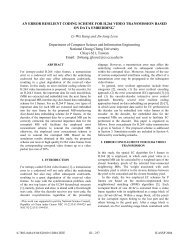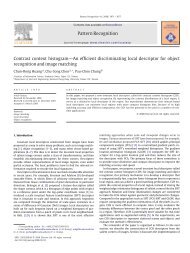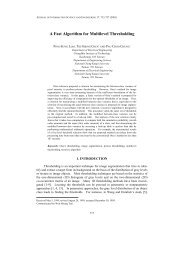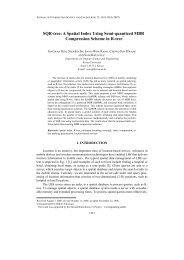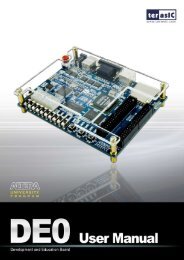Design, Implementation, and Performance Evaluation of Flash ...
Design, Implementation, and Performance Evaluation of Flash ...
Design, Implementation, and Performance Evaluation of Flash ...
You also want an ePaper? Increase the reach of your titles
YUMPU automatically turns print PDFs into web optimized ePapers that Google loves.
FLASH MEMORY-BASED FILE SYSTEM ON CHIP<br />
Host<br />
Application<br />
File<br />
Request<br />
Kernel<br />
File System<br />
Block<br />
Request<br />
Device Driver<br />
Bus<br />
Storage<br />
Media<br />
Sector<br />
Request<br />
Conventional<br />
Storage Device<br />
Host<br />
Application<br />
File<br />
Request<br />
Kernel<br />
FSOC Stub<br />
Bus File<br />
Request<br />
File System<br />
Storage<br />
Media<br />
FSOC<br />
Sector<br />
Request<br />
Fig. 1. Structure <strong>of</strong> conventional storage device <strong>and</strong> FSOC.<br />
Application<br />
Interface<br />
open()<br />
read()<br />
System<br />
write()<br />
Call<br />
unlink()<br />
mkdir()<br />
rmdir()<br />
rename()<br />
•••<br />
Host FSOC<br />
Stub<br />
Interface<br />
open_cli()<br />
read_cli()<br />
write_cli()<br />
unlink_cli()<br />
mkdir_cli()<br />
rmdir_cli()<br />
rename_cli()<br />
•••<br />
File<br />
Request<br />
FSOC<br />
Interface<br />
open_svc()<br />
read_svc()<br />
write_svc()<br />
unlink_svc()<br />
mkdir_svc()<br />
rmdir_svc()<br />
rename_svc()<br />
Fig. 2. Interface between the host <strong>and</strong> the FSOC.<br />
access requests are transmitted to the FSOC through this stub. The stub arranges the parameters<br />
<strong>of</strong> file requests <strong>and</strong> converts them to FSOC requests, which are then transmitted<br />
to the file system in the FSOC. The file system in the FSOC then fulfills the file request<br />
by making a direct request to the storage media, i.e., writes new data on the storage media<br />
or reads data from the storage media. It also updates the metadata when necessary.<br />
The results <strong>of</strong> the file operation are sent to the stub, <strong>and</strong> then passed on to the host application.<br />
The stub can be implemented as a st<strong>and</strong>-alone module or as a pseudo file system<br />
under the Virtual File System (VFS) layer [26]. In the latter case, applications can access<br />
the FSOC using an interface that is identical to other file systems.<br />
Fig. 2 shows the interface between the application <strong>and</strong> the stub, <strong>and</strong> between the<br />
stub <strong>and</strong> the FSOC file system. The FSOC interface is similar to that <strong>of</strong> an RPC (Remote<br />
Procedure Call) [27]. The FSOC has service routines corresponding to each file request,<br />
<strong>and</strong> the stub has the client routines. For example, a read operation is performed as follows:<br />
(1) the application makes a system call read() <strong>and</strong> passes the identifier <strong>of</strong> the file,<br />
the file <strong>of</strong>fset, the amount <strong>of</strong> data to be read, <strong>and</strong> the buffer address to the stub, (2) the<br />
stub executes the read_cli() routine <strong>and</strong> converts the file identifier, the file <strong>of</strong>fset, <strong>and</strong> the<br />
amount <strong>of</strong> data into an FSOC request, (3) the converted request is transmitted to the<br />
FSOC, (4) upon receiving the request, the read_svc() routine within the FSOC is called<br />
that reads data from the storage media, (5) the read_svc() routine returns the read data to<br />
the stub <strong>of</strong> the host, <strong>and</strong> (6) the stub, finally, passes the data to the application.<br />
•••<br />
1869




